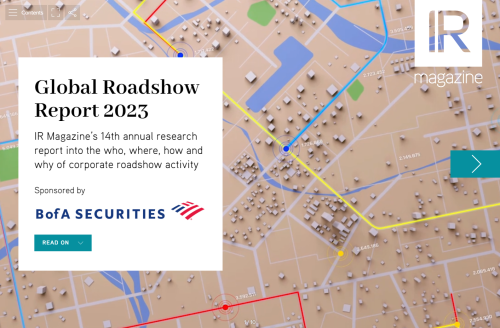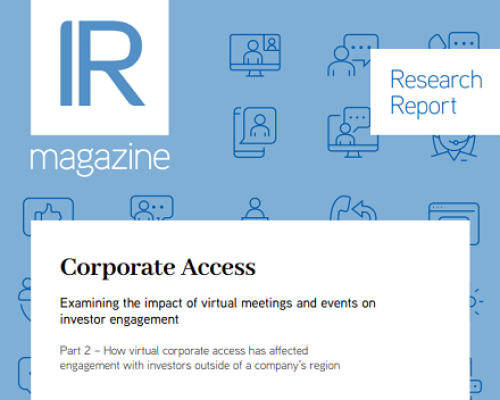In the first part of a two-part investigation into virtual roadshows, Neil Stewart finds it’s time for telepresence. Next month: desktop and mobile video
Thailand’s Indorama Ventures may be setting some kind of record, doing two to three roadshows every month, making Richard Jones, head of investor relations and corporate communications, a prime candidate to do virtual roadshows using video conferencing. But first he wants to see a rise in quality – and a drop in the price. For other IROs, that magical quality/price point has already arrived.
Video conferencing has had no shortage of opportunities to grab IR professionals’ attention, from the SARS outbreak in 2003 to the 2008-2009 financial crisis. IROs, however, often frustrated by glitches, have always gone back to flying.
Now the technology has improved and the bandwidth has increased, and many companies have invested in some level of video conferencing for communicating between their offices, from half-million dollar ‘immersive telepresence’ rooms all the way down to less elaborate systems costing just a few thousand dollars. So have investment houses; so have sell-side firms. And now the three corners of the IR equation are starting to use video conferencing to talk to each other.
Cisco, as one of the two market leaders with its TelePresence branded product, may also be the world’s number one user of the technology. The primary use is communicating with Cisco’s network equipment customers. But the company’s IROs have also become big fans. For example, in the few days following earnings announcements, top shareholders now regularly drop into telepresence suites in Cisco’s offices in New York and Boston for a quick catch-up with the CEO or CFO, supplanting traditional post-earnings callbacks.
Last year Cisco took it up a notch and hosted a global session. Investors gathered in New York, Boston, Denver and San Francisco for presentations by Cisco business leaders from around the world. Those who couldn’t come to a Cisco office for the telepresence event could listen in via webcast.
Another example was a February 2011 event organized by Bank of America Merrill Lynch (BofAML). Groups of investors in eight cities in the US and Europe joined in. Matt Hardwick, Cisco’s head of international IR, estimates that approximately 18 percent of Cisco’s total market cap was represented in the event.
Hardwick says his remit, which covers everywhere from Tokyo to London, benefits especially from telepresence. ‘For my last Asian roadshow, I put feet on the ground only in Tokyo and Singapore, but I talked to investors in Beijing, Shanghai, Hong Kong and Sydney by telepresence. What could have amounted to at least a five-day roadshow was done in two and a half days,’ he says.
Coast to coast
Polycom is the other telepresence leader, sharing the majority of the worldwide market with Cisco. In terms of its IR, Polycom is far along the tech path. It has done video webcasts of its quarterly earnings call for more than a decade, and last year CFO Mike Kourey started posting brief YouTube earnings recaps – so using its own telepresence systems for investor meetings fits right into Polycom’s IR trajectory.
In February 2009 the firm did its first bi-coastal analyst event, with investors at Polycom’s Santa Clara headquarters and its New York City conferencing center. At first investors would ask ahead of time: ‘Where will the CFO and CEO be?’ Kourey would always answer: ‘It doesn’t matter: we’re all together either way.’
No need to know the way to San JoseJanet Dignan on Cisco TelePresenceAttending a meeting at an office in the City of London with a group of equity analysts and the top brass of a US company is a pretty low-tech matter. Meeting the top brass while they remain in their West Coast US HQ could be described as rocket science. Because we really did meet them. We were in Cisco’s London headquarters; they were in Cisco’s San Jose, California headquarters. We were sitting at desks arranged in a semi-circle; they were sitting at mirror-image desks forming the other half of the circle. Of course we couldn’t shake hands. We could, however, make eye contact – with eyes that were the same size as those of the other people in our room in London. Is this the key to telepresence? The fact that the people you’re talking to are life-sized? Or is it the gazillions of gigabytes of bandwidth that allow the conversation to flow freely, notwithstanding the thousands of miles in between? Or maybe the trick is having the same furniture in both places, so it really does seem as though you’re all sitting at the same table. Whatever it is about Cisco TelePresence, it works. The old song describes finding peace of mind in San Jose – maybe you can get that now without even actually going there. |
‘Doing it bi-coastally gave investors access to a much broader swathe of the management team, and we got to meet a lot more of the investment community,’ Kourey points out.
Polycom followed up with another bi-coastal event in November 2009 then, in December 2010, turned it into a transatlantic analyst event with its new executive briefing center in London. Polycom’s chief executive, Andy Miller, was already in London on a sales trip while Kourey was in New York and other Polycom executives participated from California. Around 30 to 40 investors gathered at each of the locations.
Today Cisco investors mostly go to Cisco’s offices for telepresence events, and Polycom’s investors go to Polycom’s offices, but many brokers and large institutional investors are acquiring their own
high-end video conferencing systems, opening the way for many more IROs and their management teams to try it out. ‘It’s a great differentiator for the brokers,’ Hardwick says. Plus, public telepresence rooms that can be booked by the hour are popping up, for instance in around 13 Marriott hotels.
BofAML began a big telepresence push earlier this year and has quickly become one of Cisco’s biggest customers for the product – using it for both external and internal meetings. The investment bank’s
corporate access team has also taken notice and in recent months has started offering company managements the chance to try telepresence for investor meetings.
Amy Ellis-Simon, managing director and BofAML’s head of corporate access, says the bank has held successful group meetings – linking management in one location to investors in Texas, New York, Chicago, London, Boston and San Francisco, for example – as well as pure one-on-ones.
Kourey hints that Polycom is currently working with an unnamed company on a large investor conference involving numerous issuers that will rely on telepresence. ‘Imagine an investor conference without any of the travel or time loss usually associated with it,’ he says. ‘People are hungry for it.’
Breakdown in communications
John Schoger, president and co-founder of Voyager Institutional Services, an independent corporate access firm in Columbus, Ohio, has organized a few telepresence meetings for some of the Midwest’s biggest institutional investors. He’s skeptical about ‘interoperability’, or the ability of different companies’ video conferencing facilities to interact. ‘Big issuers and investors have these million-dollar systems but they’re not talking to each other,’ he says. ‘It should be as easy as picking up the phone.’
Clariant, a Swiss specialty chemicals firm, has a top-notch video conferencing system to connect its offices around the world; so does institutional investor AllianceBernstein. But when Siegfried Schwirzer, Clariant’s deputy head of IR, tried to set up a telepresence meeting between the two, it was a disaster. ‘Our system didn’t communicate with Alliance’s,’ he says.
Kourey says problems with interoperability will soon be history. For example, Polycom recently launched the Open Visual Communications Consortium with 14 of the world’s biggest telecommunications firms, aiming to make video conferencing more seamless between carriers.
As more buy-side firms begin to use telepresence, room-based video conferencing systems or desktop video, Kourey has been doing more one-on-ones using video. He adds that he schedules a half-hour for a phone call but a whole hour if it’s a video call: ‘Video is simply much more productive.’
For now though, most IR professionals say the demand for live meetings remains high and telepresence meetings are still rare. Interviewed via video from Bangkok, Jones says he would use video conferencing if it were dramatically cheaper than taking a plane and staying in a hotel.
But having tried a desktop virtual roadshow system and looked at a telepresence system but found it too expensive, he is happy to keep flying.
This article appeared in the September print edition of IR magazine.










